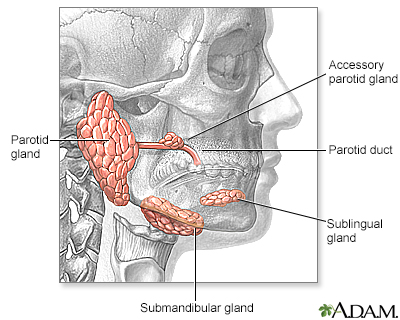Salivary duct stones
Sialolithiasis; Salivary calculi
Salivary duct stones are deposits of minerals in the ducts that drain the salivary glands. Salivary duct stones are a type of salivary gland disorder.
Images

Causes
Spit (saliva) is produced by the salivary glands in the mouth. The chemicals in saliva can form a hard crystal that can block the salivary ducts.
When saliva cannot exit a blocked duct, it backs up into the gland. This may cause pain, swelling, or an infection of the gland.
There are three pairs of major salivary glands:
- Parotid glands -- These are the two largest glands. One is located in each cheek over the jaw in front of the ears. Inflammation of one or more of these glands is called parotitis, or parotiditis.
- Submandibular glands -- These two glands are located just under both sides of the jaw and carry saliva up to the floor of mouth under the tongue.
- Sublingual glands -- These two glands are located just under the front area of the floor of the mouth.
Salivary stones most often affect the submandibular glands. They can also affect the parotid glands.
Symptoms
Symptoms include:
- Problems opening the mouth or swallowing
- Dry mouth
- Pain in the face or mouth
- Swelling of the face or neck (can be severe when eating or drinking)
The symptoms occur most often when eating or drinking.
Exams and Tests
The health care provider or dentist will do an exam of your head and neck to look for one or more enlarged, tender salivary glands. The provider may be able to find the stone during the exam by feeling under your tongue.
Tests such as x-rays, ultrasound, MRI scan, or CT scan of the face are used to confirm the diagnosis.
Treatment
The goal is to remove the stone.
Steps you can take at home include:
- Drinking lots of water
- Using sugar-free lemon drops to increase the amount of saliva
Other ways to remove the stone are:
- Massaging the gland with heat -- The provider or dentist may be able to push the stone out of the duct.
- In some cases, you may need surgery to cut out the stone.
- A newer treatment that uses shock waves to break the stone into small pieces is another option.
- A technique called sialendoscopy, can diagnose and treat stones in the salivary gland duct using very small cameras and instruments.
- If stones become infected or come back often, you may need surgery to remove the salivary gland.
Outlook (Prognosis)
Most of the time, salivary duct stones cause only pain or discomfort, but at times become infected.
When to Contact a Medical Professional
Contact your provider if you have symptoms of salivary duct stones.
Related Information
Salivary gland infectionsReferences
Elluru RG. Physiology of the salivary glands. In: Flint PW, Francis HW, Haughey BH, et al, eds. Cummings Otolaryngology: Head and Neck Surgery. 7th ed. Philadelphia, PA: Elsevier; 2021:chap 81.
Jackson NM, Mitchell JL, Walvekar RR. Inflammatory disorders of the salivary glands. In: Flint PW, Francis HW, Haughey BH, et al, eds. Cummings Otolaryngology: Head and Neck Surgery. 7th ed. Philadelphia, PA: Elsevier; 2021:chap 83.
Orlowski HLP, Miller-Thomas M. Diagnostic imaging and fine-needle aspiration of the salivary glands. In: Flint PW, Francis HW, Haughey BH, et al, eds. Cummings Otolaryngology: Head and Neck Surgery. 7th ed. Philadelphia, PA: Elsevier; 2021:chap 82.
BACK TO TOPReview Date: 9/10/2023
Reviewed By: Josef Shargorodsky, MD, MPH, Johns Hopkins University School of Medicine, Baltimore, MD. Also reviewed by David C. Dugdale, MD, Medical Director, Brenda Conaway, Editorial Director, and the A.D.A.M. Editorial team.

Health Content Provider
06/01/2025
|
A.D.A.M., Inc. is accredited by URAC, for Health Content Provider (www.urac.org). URAC's accreditation program is an independent audit to verify that A.D.A.M. follows rigorous standards of quality and accountability. A.D.A.M. is among the first to achieve this important distinction for online health information and services. Learn more about A.D.A.M.'s editorial policy, editorial process and privacy policy. A.D.A.M. is also a founding member of Hi-Ethics. This site complied with the HONcode standard for trustworthy health information from 1995 to 2022, after which HON (Health On the Net, a not-for-profit organization that promoted transparent and reliable health information online) was discontinued. |
The information provided herein should not be used during any medical emergency or for the diagnosis or treatment of any medical condition. A licensed medical professional should be consulted for diagnosis and treatment of any and all medical conditions. Links to other sites are provided for information only -- they do not constitute endorsements of those other sites. © 1997- 2025 A.D.A.M., a business unit of Ebix, Inc. Any duplication or distribution of the information contained herein is strictly prohibited.
